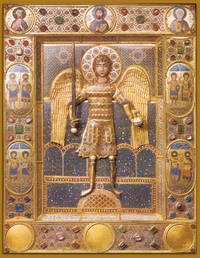Byzantium
dal 24/10/2008 al 21/3/2009
Segnalato da
24/10/2008
Byzantium
Royal Academy of Arts, London
Highlighting the splendours of the Byzantine Empire, the display comprises around 300 objects including icons, detached wall paintings, micro-mosaics, ivories, enamels plus gold and silver metalwork. Some of the works have never been displayed in public before. The exhibition includes great works from the San Marco Treasury in Venice and rare items from collections across Europe, the USA, Russia, Ukraine and Egypt.

Highlighting the splendours of the Byzantine Empire, Byzantium 330–1453 comprises around 300 objects including icons, detached wall paintings, micro-mosaics, ivories, enamels plus gold and silver metalwork. Some of the works have never been displayed in public before.
The exhibition includes great works from the San Marco Treasury in Venice and rare items from collections across Europe, the USA, Russia, Ukraine and Egypt. The exhibition begins with the foundation of Constantinople in 330 AD by the Roman Emperor Constantine the Great and concludes with the capture of the city by the Ottoman forces of Mehmed II in 1453. This is the first major exhibition on Byzantine Art in the United Kingdom for 50 years.
This epic exhibition has been made possible through a collaboration between the Royal Academy of Arts and the Benaki Museum, Athens.
Byzantium 330–1453 follows a chronological progression covering the range, power and longevity of the artistic production of the Byzantine Empire through a number of themed sections. In this way the exhibition explores the origins of Byzantium; the rise of Constantinople; the threat of iconoclasm when emperors banned Christian figurative art; the post-iconoclast revival; the remarkable crescendo in the Middle Ages and the close connections between Byzantine and early Renaissance art in Italy in the 13th and early 14th centuries.
Between 1204 and 1261, Constantinople was in the hands of the Latin Crusaders, but the return of the Byzantine Emperors to the city initiated a final period of great diversity in art. Art from Constantinople, the Balkans and Russia show the final phase of refinement of distinctively Orthodox forms and functions, while Crete artists like Angelos Akotantos signed their icons and merged Byzantine and Italian styles. Up to the end of the Byzantine Empire, with the fall of Constantinople to the Ottoman Turks in 1453, manuscripts, micromosaics and metalwork demonstrates the virtuosity of its artists.
The exhibition shows the long history of Byzantine art and documents the patrons and artists and the world in which they lived. Seeing themselves as the members of a Christian Roman Empire they believed that they represented the culmination of civilisation on earth. The art emits an intellectual, emotional and spiritual energy, yet is distinctive for the expression of passionate belief and high emotion within an art of moderation and restraint.
Byzantium 330-1453 showcases the Antioch Chalice (left), on loan from the Metropolitan Museum of Art, New York. After its discovery in c.1911, the silver gilt artefact was believed to have been the Holy Grail, the cup used by Christ at the Last Supper. Major works from the Treasury of San Marco, Venice have been loaned to the Royal Academy including the ornate Chalice of the Patriarchs, c. 10th–11th century. Other highlights include a two-sided icon of Virgin Hodegetria (obverse) and the Man of Sorrows (reverse), 12th century, from the Byzantine Museum, Kastoria, an impressive 10–11th century imperial ivory casket from Troyes cathedral depicting hunting scenes and riders and the Homilies of Monk James Kokkinobaphos, a manuscript from 1100–1150AD on loan from the Bibliothèque Nationale de France, Paris.
Byzantium 330–1453 has been organised by the Royal Academy of Arts and the Benaki Museum, Athens. The exhibition has been curated by Professor Robin Cormack, Courtauld Institute, London, Professor Maria Vassilaki, University of Thessaly at Volos and the Benaki Museum and Dr Adrian Locke, Acting Head of Exhibitions, Royal Academy of Arts.
Objects eligible for protection under Part 6 of the Tribunals, Courts and Enforcement Act 2007
Sponsor
The J.F. Costopoulos Foundation, the A.G. Leventis Foundation, and the Stavros Niarchos Foundation are very proud to support the exhibition Byzantium 330-1453.
The three Foundations are committed to promoting and preserving Hellenic culture and heritage in Greece and abroad. Furthermore, the Foundations aim to express their active support for collaborative projects between acclaimed international institutions, realised in this case by the Benaki Museum in Athens and the Royal Academy of Arts in London.
The J.F. Costopoulos Foundation, the A.G. Leventis Foundation, and the Stavros Niarchos Foundation have a long tradition of supporting major exhibitions of Byzantine Art and hope that, through their collaboration with such renowned cultural organisations, they will enhance the audience’s understanding of a very significant culture.
Royal Academy of Arts
Burlington House Piccadilly - London



